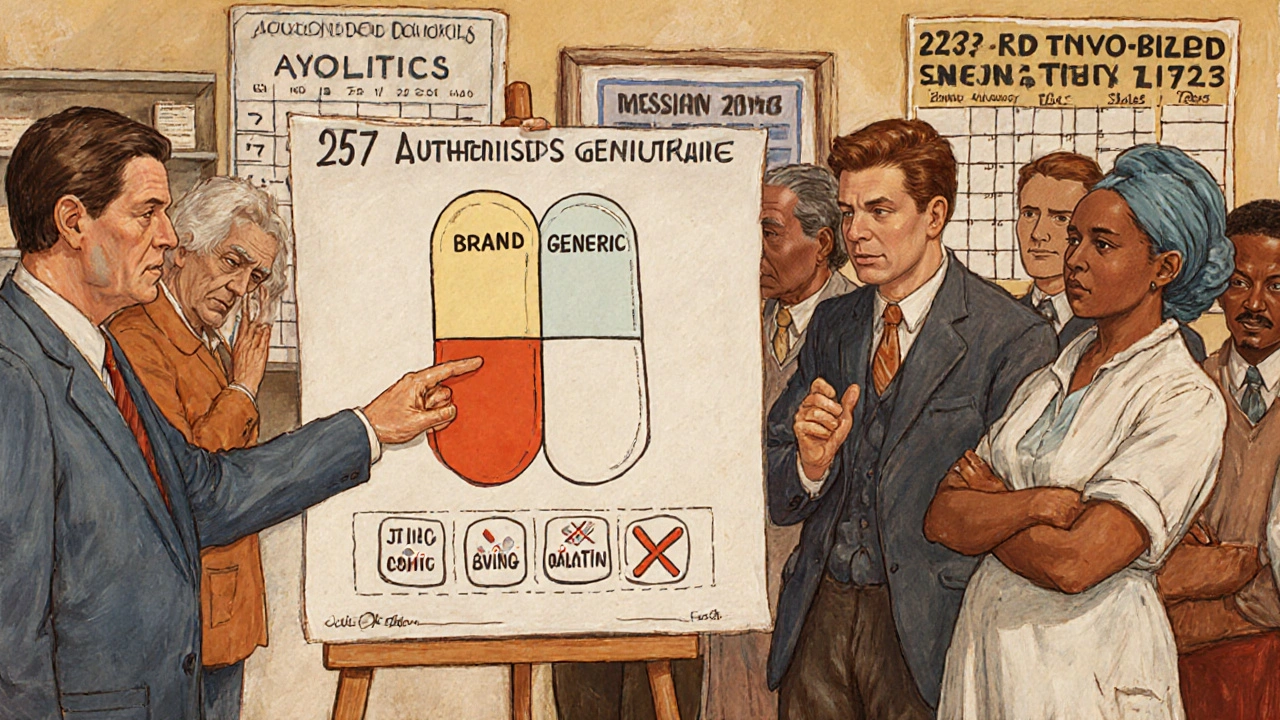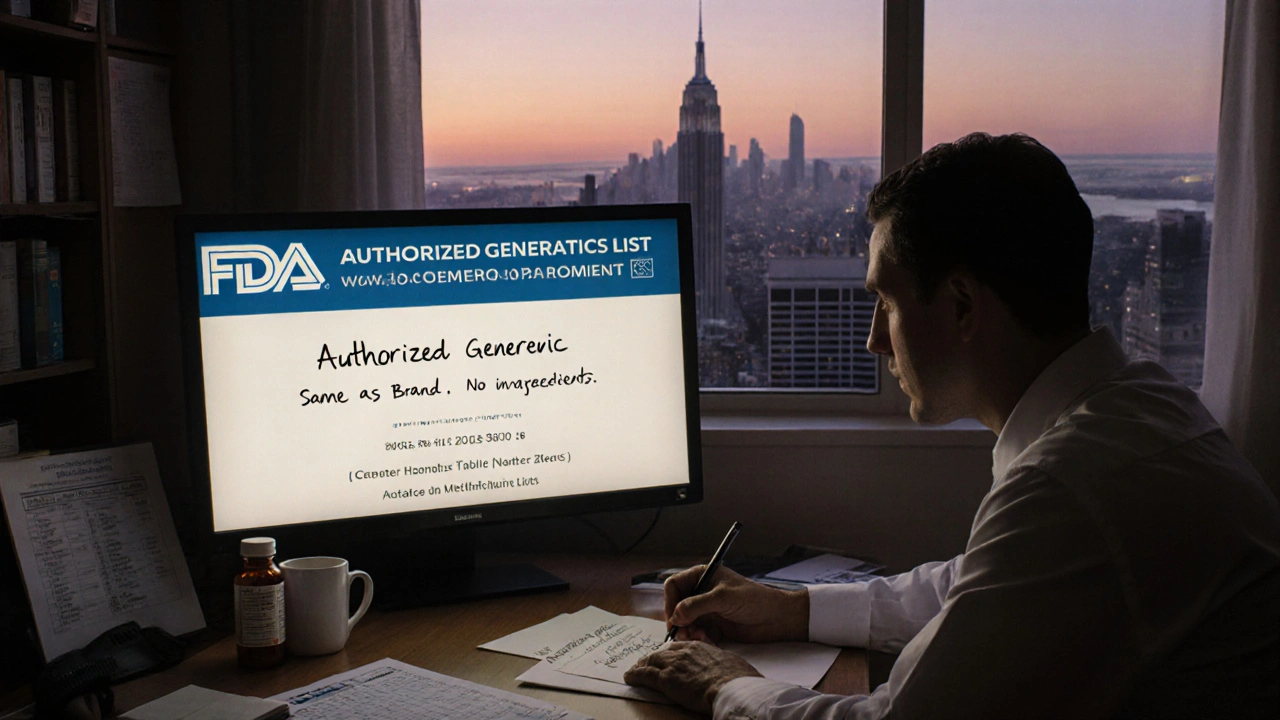When a patient walks into the pharmacy with a prescription for a brand-name drug, the first thing most pharmacists think about is cost. But here’s the thing: not all generics are created equal. Some look different, taste different, even cause side effects-not because the active ingredient changed, but because the inactive ingredients did. That’s where authorized generics come in. They’re not just cheaper alternatives. In many cases, they’re the only safe swap.
What Exactly Is an Authorized Generic?
An authorized generic is the exact same medication as the brand-name drug-same active ingredient, same inactive ingredients, same manufacturing process. The only difference? No brand name on the label. It’s made by the original drug company, or under their direct license, and sold without the fancy packaging or marketing. Think of it like buying a Coca-Cola bottle that says "Cola" instead of "Coca-Cola"-same recipe, same factory, same taste.
Unlike regular generics, which must prove they’re "bioequivalent" through FDA testing, authorized generics skip that step because they’re literally the same product. The FDA requires manufacturers to list these drugs quarterly, and as of September 2023, there were 257 authorized generics on the market. That’s about 5% of all brand-name drugs with generic options-but that number is growing fast.
When to Recommend Authorized Generics Over Regular Generics
Here’s where it gets practical. You don’t just swap any generic for any brand. You choose based on the patient’s needs. There are three clear situations where an authorized generic isn’t just a good idea-it’s the best option.
1. Patients With Allergies or Dietary Restrictions
Regular generics often use different fillers, dyes, or binders than the brand. For someone with celiac disease, that means gluten. For someone avoiding animal products, it could mean gelatin or lactose. I’ve had patients come back upset because their new generic pill gave them stomach cramps-not because the medicine didn’t work, but because the new version had wheat starch.
Authorized generics don’t have this problem. They use the exact same inactive ingredients as the brand. If your patient tolerates the brand, they’ll tolerate the authorized generic. That’s huge for people with allergies, religious dietary needs, or autoimmune conditions. Always check the inactive ingredients on the brand label first. If they’re sensitive, skip the regular generic. Go straight to the authorized version.
2. Narrow Therapeutic Index (NTI) Drugs
Some drugs have a razor-thin margin between working and causing harm. Warfarin, levothyroxine, phenytoin-these are NTI drugs. Even tiny differences in how the body absorbs the active ingredient can lead to blood clots, thyroid crashes, or seizures.
The FDA has documented cases where switching from brand to regular generic caused problems in 3-5% of patients on these drugs. That’s not rare. That’s clinically significant. Authorized generics eliminate this risk because they’re chemically identical. No bioequivalence guesswork. No absorption variability. Just the same pill, same dose, same effect.
3. Modified-Release Formulations
Think extended-release tablets, delayed-release capsules, or patches. These aren’t just about how much drug is in the pill-they’re about how slowly it’s released. Regular generics must meet FDA bioequivalence standards, but those standards don’t always catch subtle differences in release timing.
I’ve seen patients on extended-release methylphenidate switch to a generic and suddenly feel jittery by midday, then crash by 4 p.m. The brand’s delivery system was precise. The generic’s wasn’t. Authorized generics? Same delivery system. Same timing. Same results.
How to Spot an Authorized Generic
You can’t tell by looking at the pill. One might be blue, another white. Same medicine. Different color. So how do you know?
Start with the FDA’s quarterly list of authorized generics. It’s updated every three months and free to access. Look up the brand name. If there’s an authorized generic listed, it will show the manufacturer-usually the same company that makes the brand (Pfizer, Merck, etc.) or an authorized partner like Prasco or Greenstone.
Check the National Drug Code (NDC). The labeler code (first part of the NDC) will match the brand’s manufacturer, not a typical generic company. That’s your clue. If the labeler code is Pfizer, but the pill says "Methylphenidate ER 20 mg," you’ve got an authorized generic.
Also, check your pharmacy’s wholesaler. Some authorized generics are only distributed through certain channels. Prasco’s products, for example, are mostly available through AmerisourceBergen and Cardinal Health-not McKesson. If you can’t find it, call your distributor. Don’t assume it’s not available.

Insurance and Cost: The Hidden Trap
Here’s the catch: even though authorized generics are chemically identical to the brand, many pharmacy benefit managers (PBMs) treat them as brand-name drugs for pricing. That means higher copays.
A 2022 study found that 63% of PBMs put authorized generics in the brand-tier formulary. So even if the pill costs $5 instead of $150, your patient might pay $40 instead of $10. That’s confusing. That’s frustrating. That’s why you need to explain it.
Always check the patient’s plan. If the authorized generic is cheaper than the brand, even with a brand-tier copay, recommend it. If the regular generic is cheaper and safe, go with that. But if the patient has sensitivities or is on an NTI drug, the authorized generic is worth fighting for-even if it means calling the insurer.
What to Tell Your Patients
Patients get nervous when their pill changes color or shape. A 2022 study found that 27% stopped taking their medication after a packaging change-unless they were told why. That’s not noncompliance. That’s fear.
Don’t just hand them the bottle. Say this: "This is the same medicine you were taking before, made by the same company. The only difference is it doesn’t have the brand name on it. That’s why it’s cheaper. The inside of the pill is identical-same ingredients, same dose, same effect. You shouldn’t feel any different. If you do, call us right away."
For patients on chronic meds, write it down. Give them a note: "Authorized Generic - Same as Brand. No change in ingredients."

Legal and Documentation Notes
In 42 states, pharmacists can substitute an authorized generic without prescriber approval-same as regular generics-as long as the prescription doesn’t say "Do Not Substitute." But 18 states require you to notify the prescriber. Know your state rules.
Document everything. Use the "DA" modifier in your billing system for drug substitution. Keep a record of why you chose the authorized generic-especially if it’s for allergy, NTI, or modified-release reasons. If there’s ever a review, you’ll be glad you did.
What’s Changing in 2025?
Authorized generics are growing. The number has increased by 18% each year since 2010. More drugs are getting them. More patients are asking for them-GoodRx reports a 47% jump in searches for "authorized generics" in just one year.
Legislation like the Affordable Insulin Now Act of 2023 could push more manufacturers to offer authorized versions of high-cost drugs. And professional groups like the American Pharmacists Association are working on updated guidelines for 2024 that will make recommending them even clearer.
Bottom line: this isn’t a niche topic anymore. It’s a core part of safe, cost-effective pharmacy practice.
Final Checklist for Pharmacists
- Check the FDA’s quarterly list of authorized generics before recommending any substitution.
- Always compare inactive ingredients-especially for patients with allergies, celiac disease, or dietary restrictions.
- Prefer authorized generics for NTI drugs: warfarin, levothyroxine, phenytoin, digoxin, lithium.
- Use authorized generics for extended-release, delayed-release, or complex delivery systems.
- Verify insurance tier placement-authorized generics may cost more out-of-pocket than expected.
- Explain the pill change clearly to patients. Write it down. Prevent discontinuation.
- Know your state’s substitution laws. Some require prescriber notification.
Are authorized generics the same as brand-name drugs?
Yes. Authorized generics are manufactured by the same company that makes the brand-name drug, using the exact same formula, including active and inactive ingredients. The only difference is the label and packaging-they’re sold without the brand name. This makes them chemically identical, not just "similar."
Why are authorized generics cheaper if they’re identical?
They’re cheaper because they don’t carry the marketing, advertising, or brand-name markup. The manufacturer saves money by selling without the brand name, and those savings are passed to the pharmacy and patient. Savings typically range from 20% to 80% compared to the brand-name version.
Can I substitute an authorized generic without the prescriber’s permission?
In most states (42 out of 50), yes-unless the prescription says "Do Not Substitute." But 18 states require you to notify the prescriber. Always check your state’s pharmacy board rules before substituting.
Do authorized generics show up in the Orange Book?
No. The Orange Book lists therapeutic equivalence ratings for regular generics. Authorized generics aren’t listed separately because they’re not different drugs-they’re the brand product with a different label. The FDA considers them automatically therapeutically equivalent.
Why does my insurance charge me more for an authorized generic than a regular generic?
Many pharmacy benefit managers (PBMs) classify authorized generics as brand-name drugs in their formularies-even though they’re chemically identical. This means higher copays. Always check your patient’s plan details. If the authorized generic costs less than the brand, even with a higher copay, it may still be the best option.
How do I know if a generic is authorized or regular?
Check the FDA’s quarterly Authorized Generic List or look up the NDC code. If the labeler code matches the brand-name manufacturer (like Pfizer or Merck), it’s an authorized generic. If it’s a company like Teva, Mylan, or Sandoz, it’s a regular generic. You can also ask your wholesaler.

Patrick Marsh
November 23, 2025 AT 20:01Authorized generics are a game-changer. I’ve had patients crash on levothyroxine generics-then switch to the authorized version and feel like a new person. No guesswork. Just science.
Danny Nicholls
November 25, 2025 AT 13:53OMG YES 🙌 I’ve been pushing this for years and everyone acts like I’m speaking Klingon. Seriously though-check those inactive ingredients! Celiac patients are NOT okay with random wheat starch. #PharmacistLife
Robin Johnson
November 25, 2025 AT 19:49This is exactly why we need better education in pharmacy school. I’ve seen too many new grads swap generics like they’re trading baseball cards. No. Not all pills are created equal. Authorized generics aren’t optional for NTI drugs-they’re mandatory. Period.
Latonya Elarms-Radford
November 27, 2025 AT 02:21Let’s be honest-this isn’t just about pharmacology. It’s about the existential crisis of identity in modern medicine. We’ve commodified healing. The brand name was a promise-a covenant between patient and physician. Now we’re handing out unlabeled pills like coupons at a gas station. Is this progress? Or just capitalism dressed in white lab coats? The authorized generic is a mirror reflecting our collective surrender to cost-efficiency over care. The pill doesn’t change. But we do. And that’s the real tragedy.